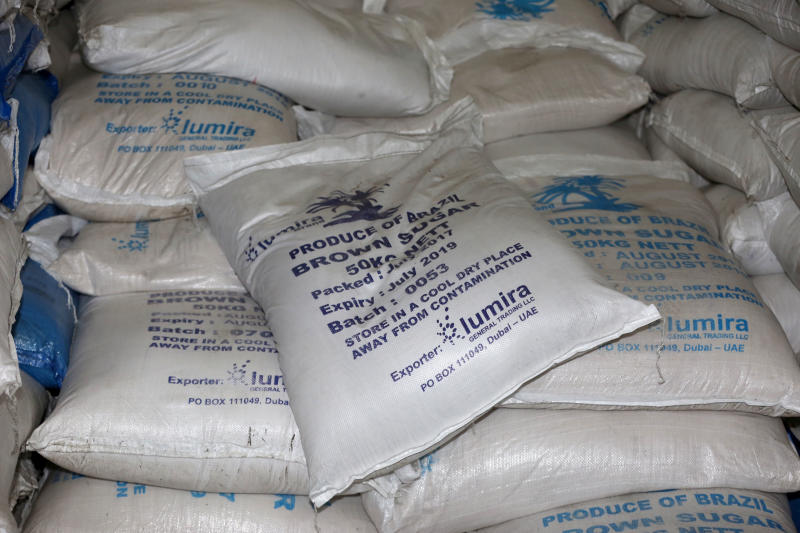
Food adulteration to increase shelf life is one of the ways chemicals like mercury end up in your sugar.
In other cases, as an expert revealed to The Standard, residue from these toxic chemicals end up in food during processing and the post-harvest period.
However, as Catherine Kunyanga from the University of Nairobi's Department of Food Science and Technology also noted, it is not the chemicals themselves that should scare people, but the state in which they are found.
She says this is because while some chemicals are generally toxic, like mercury, others such as copper can be ingested in a form not injurious to one's health.
The safety state and levels of these chemicals can only be determined in an equipped laboratory.
Interior Cabinet Secretary Fred Matiang’i last week claimed some of the sugar consumed by Kenyans was illegal and hence "poison".
Analyses of more than 1,300 bags of sugar by the Government Chemist, in a report yet to be made public, showed that the consignment was not cleared by the Kenya Bureau of Standards (Kebs) and that it contained mercury, copper, mould and yeast.
Such revelations have thrown Kenyans into panic, with some resorting to finding out if any tests can be conducted at home to determine if their sugar has heavy metals.
Generally, the presence of mould and yeast is a sign of either poor storage or expiry of foodstuff.
Government Chemist Ali Gakweli said although home tests (if existing) could increase awareness of such incidents, they could also cause unnecessary unrest among consumers.
But just how does mercury or copper find its way into your sugar or any other food?
“We know for pesticides it is during production. But for heavy metals, it is during harvest, post-harvest and also during processing,” said UoN's Dr Kunyanga.
Some manufacturers or traders have been faulted for intentionally adding the chemicals for preservation purposes.
As documented in the Draft Winsonsin Mercury Source book on mercury use in agriculture, this toxic chemical was widely in use before 1970 by farmers as a fungicide and pesticide.
"All food uses of mercury-containing pesticides were cancelled in 1969, and all US pesticide registrations were cancelled as of early 1995,” reads the handout drafted by John Wilekson from the Minnesota Pollution Control Agency.
The sugar that was intercepted in Kenya was said to be originally from Zambia and Brazil, at least according to the packaging labels.
But as Kunyanga said, it would be difficult to find out the exact point of entry of the toxic chemicals.
Not all mercury, copper and other chemicals are harmful to the body when consumed.
As Kunyanga revealed, what makes these chemicals toxic is the state in which they are consumed.
For example, copper is an important element in the formation of red blood cells in the body, and any reduced levels of copper, according to MayoClinic.com, can result in anaemia and weak bones.
Other conditions that may increase your need for a copper-based diet are kidney and pancreatic diseases.
Wilson’s disease
Similarly, an increase in the quantity of copper in your system can be fatal as it has been associated with Wilson’s disease: accumulation of copper in the brain, liver and other vital organs.
Kunyanga however noted that in the case of mercury, its toxicity could end up tampering with the nervous system, thereby exposing a person to paralysis and endangering unborn children.
According to the World Health Organisation, every person has been exposed to some level of mercury, and the fact that it has not affected them means it has not accumulated to toxic levels, or the exposure was not fatal like in cases of industrial exposure.
But since you have been using the contaminated sugar in moderate quantities, it may take years before the effects of the heavy metal takes a toll on your health.
“You may not see some of these effects now but these chemicals, for example mercury, accumulate in your body and years down the line, when you are 70, you are diagnosed with cancer and you wonder, where did that come from?” said Kunyanga.
 The Standard Group Plc is a multi-media organization with investments in media platforms spanning newspaper print
operations, television, radio broadcasting, digital and online services. The Standard Group is recognized as a
leading multi-media house in Kenya with a key influence in matters of national and international interest.
The Standard Group Plc is a multi-media organization with investments in media platforms spanning newspaper print
operations, television, radio broadcasting, digital and online services. The Standard Group is recognized as a
leading multi-media house in Kenya with a key influence in matters of national and international interest.











